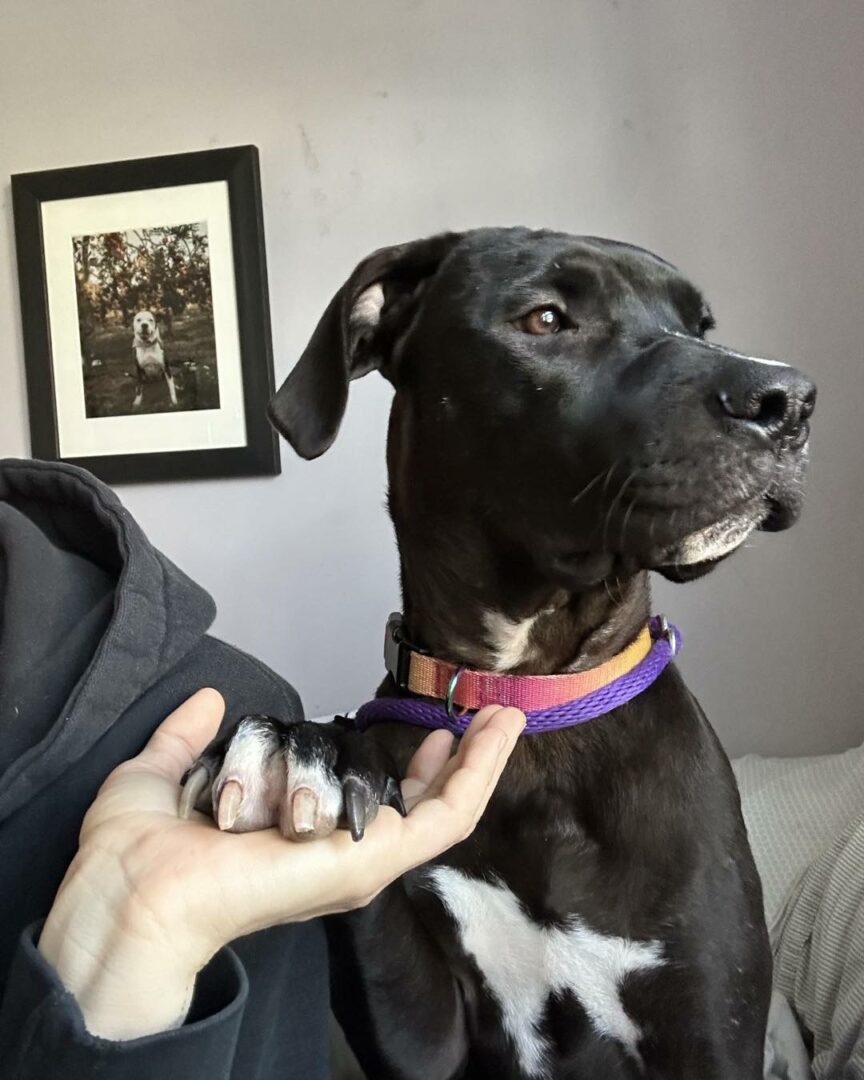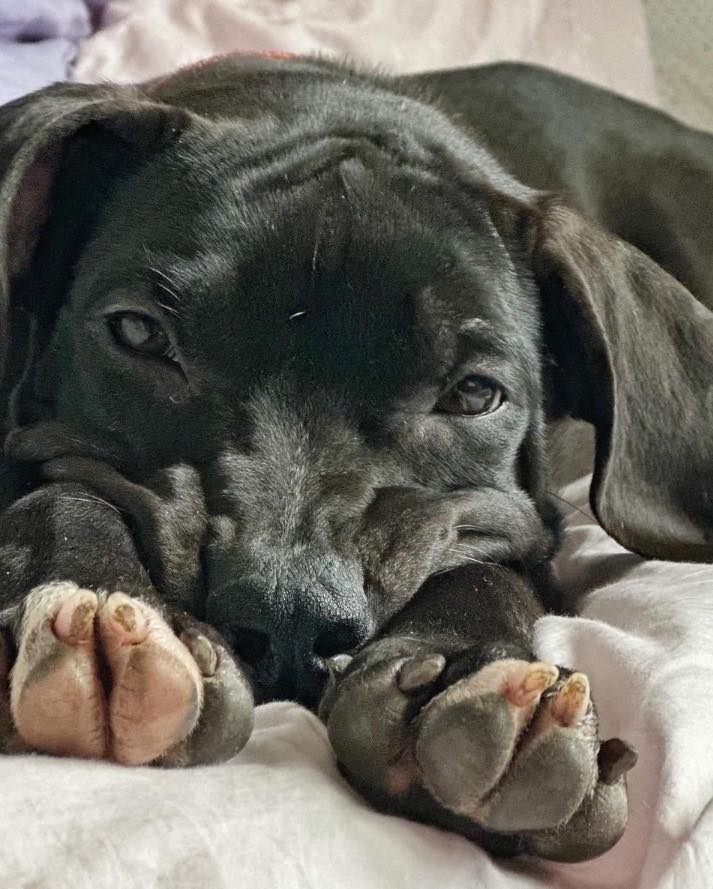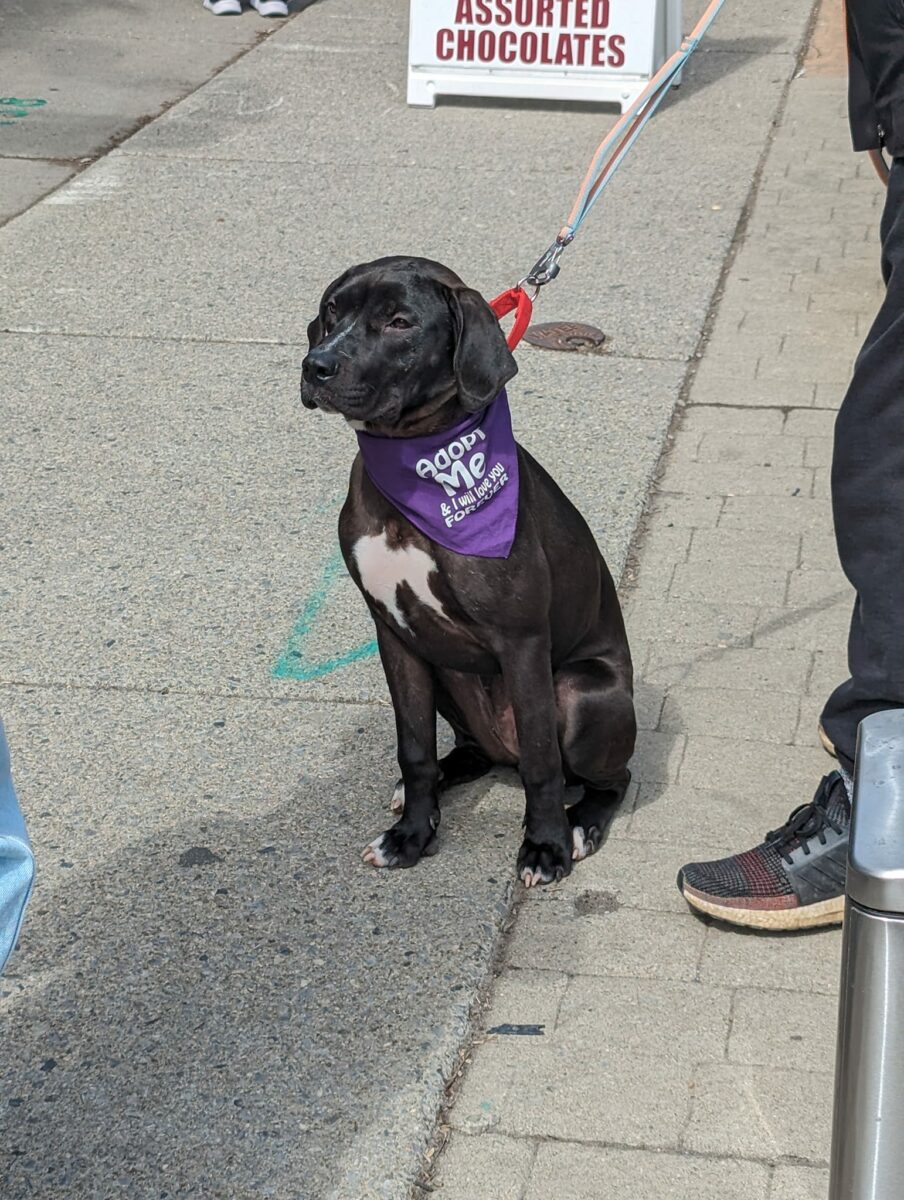A dog is truly a man’s best friend. These kind-hearted animals stick with their hoomans through thick and thin. They’re always there to hold your hand.
Their loyalty isn’t in question here.
It’s ours.
Are you, hooman, ready to be there for your dog?
Are you ready to hold your dog’s hand whenever he or she needs it?
The following story is about Dolly, a rescue dog who really needed a helping hand.
The Dog With An Unusual Habit

From the moment she stepped into the shelter, they knew she was a sweet girl.
She was even housebroken.
So, why wasn’t a young dog like Dolly adopted that very same day?
Time passed, day after day, and Dolly was still there.
As soon as the potential adopters ignore the black dog syndrome.

The black dog syndrome? Is that what I think it is?
Unfortunately, yes.
The black dog syndrome is something dark-colored dogs experience in shelters. People usually skip on such dogs because they’re either not as stunning-looking as some other colors, or else they are considered dangerous. |1|
Of course, that couldn’t be any further from the truth. That’s just a silly superstition.
All dogs are equally valuable. All shelter dogs deserve a loving home.
And, that’s one step closer to the ideal scenario.
When Katie first brought Dolly home, she was a shy girl with zero confidence. It did not take long for Katie to connect with Dolly and bring out the best in her. Dolly truly blossomed into a confident pooch who loves her new life.
Being so fun-loving and sweet isn’t the only thing Katie learned about Dolly. Her foster mom also learned that Dolly has a unique habit: she insists on holding hands!

It all began when Katie wanted to teach Dolly the command “paw.” Dolly liked it so much that she kept on putting her paw up, asking for attention. It was Dolly’s way of getting extra cuddles from Katie.
“Then it turned into if I was sitting down she would jump up on the bed or couch and sit next to me and instantly put her paw out for me to hold,” Katie said. “She is just so desperate for my attention and affection. She especially loves doing it in the car for some reason.”
As soon as Katie starts the car, there’s Dolly, calling shotgun and holding her paw up in the air as if she is asking for emotional support during the ride.
Paw In Hand Makes A Difference

I believe it’s finally time to ditch such false beliefs and adopt all dogs no matter their color, coat type, breed, or gender.
Shelter statistics are devastating each year. Compared to other U.S. states, the situation in New York is quite good. The total saving rate is 90.6%, with room for improvement, as always.
Not a lot of dogs like Dolly get a second chance. Not a lot of dogs like Dolly get a loving foster mom who would go out and about to meet their needs and help find them a furever home.
Dolly is truly a lucky gal. She’s got someone to snuggle with her all the time, bring her treats, and work hard on her future.
Most importantly, she’s got someone to hold her paw.
Think about how many dogs never get someone to hold their paw!
Will you be the one to reach out and give your hand?
Because a paw in hand makes a difference today, tomorrow, and forever.
Sources:
|1| HJ Svoboda, CL Hoffman. Investigating the role of coat colour, age, sex, and breed on outcomes for dogs at two animal shelters in the United States. (2023). DOI
Ever noticed how your furry friend greets you at the door with uncontainable excitement, wagging their tail furiously, and showering you with sloppy kisses? As a seasoned dog trainer, you’ve witnessed countless heartwarming moments that make you wonder about the depth of your dog’s affection. Observing their unwavering loyalty and the joy they express in your presence, you can’t help but ponder: does your dog truly love you?
In your daily interactions, whether it’s the soulful gaze they give you or the way they snuggle up beside you, there’s an undeniable bond that goes beyond mere companionship. As someone well-versed in canine behavior, you understand the subtle cues and gestures that convey a range of emotions. But amidst all the tail wags and playful antics, the question lingers in your mind: is it possible that your dog’s love for you runs deeper than you ever imagined?
Understanding Canine Emotions
When it comes to comprehending your furry friend’s emotions, dogs have quite a nuanced way of expressing themselves. Understanding these expressions can provide insight into whether your dog genuinely loves you. Here’s how you can decode your dog’s emotions:
1. Tail Wagging:
A wagging tail is often a sign of happiness and excitement in dogs. The speed and direction of the wag can convey different emotions. A fast wagging tail could mean your dog is thrilled to see you, while a slow wag might indicate caution or uncertainty.
2. Eye Contact:
Dogs use eye contact to establish a connection with their human companions. A loving gaze with soft eyes can signify affection and trust. Maintaining eye contact with you shows that your dog feels safe and secure in your presence.
3. Physical Touch:
Snuggling, leaning against you, or placing a paw on your hand are all ways dogs show their affection. Physical contact releases oxytocin, the “love hormone,” in both dogs and humans, strengthening the bond between you and your furry buddy.
4. Vocalizations:
Whether it’s joyful barks, contented sighs, or even gentle whimpers, dogs communicate their emotions through vocalizations. Understanding the tone and pitch of their sounds can help you interpret how they’re feeling.
By recognizing these emotional cues, you can gain a deeper understanding of your dog’s affection towards you. Paying attention to these subtle signs will help solidify the special bond you share with your loyal companion.
Signs Your Dog Shows Affection
1. Excited Greetings
When you come home and your dog greets you with enthusiasm, wagging their tail, jumping up, and even bringing you their favorite toy, it’s a clear sign of affection. This is your dog’s way of showing how happy they are to see you.
2. Cuddling and Snuggling
If your dog loves to cuddle up next to you on the couch or snuggle in bed, it’s because they feel safe and comfortable being close to you. This physical closeness is a strong display of affection and reinforces the bond between you and your furry friend.
3. Leaning Against You
When your dog leans against you or rests their head on your lap, they are seeking your attention and comfort. This gesture shows that they trust you and enjoy your presence. It’s a heartwarming display of affection that strengthens your connection.
4. Playfulness and Laughter
Engaging in playtime with your dog, whether it’s a game of fetch or chasing each other around, is a way for them to show their affection. Their playful attitude and joyous barks are clear indicators of their happiness and love for spending time with you.
5. Following You Around
If your dog follows you from room to room, it’s because they enjoy your company and want to be close to you. This behavior demonstrates their loyalty and deep attachment to you, showing that they find comfort and security in your presence.
6. Making Eye Contact
Maintaining eye contact with your dog is a powerful way for them to communicate their love and trust. When your dog looks into your eyes with a soft gaze, it’s a sign of their affection and emotional connection with you.
7. Tail Wagging
While tail wagging can indicate various emotions, a wagging tail in combination with other positive cues like relaxed body language and happy barks shows your dog’s affection and happiness. Pay attention to the way your dog wags their tail in different situations to understand their emotions better.
8. Bringing You Gifts
When your dog brings you their favorite toy or a random object as a “gift,” it’s their way of showing affection and sharing something they value with you. Accepting these gifts with gratitude strengthens the bond between you and your furry companion.
Factors That Influence a Dog’s Love
Socialization Experience
When dogs are adequately socialized from a young age, they tend to form stronger bonds with their owners. In situations where they have positive interactions with various people, animals, and environments during their critical socialization period, typically up to 12-16 weeks, they are likely to exhibit more affectionate behaviors towards those they have bonded with.
Breed Characteristics
Different breeds of dogs have varying levels of affection and attachment tendencies. Some breeds are known for being more independent, while others are bred to be highly loyal and loving towards their owners. Understanding your dog’s breed characteristics can give you insights into how they might express their love towards you.
Your Behavior and Interactions
Your actions and interactions with your dog play a significant role in how much love and affection they show you in return. Spending quality time with your dog, providing proper care, consistent training, and positive reinforcement can enhance the bond between you and your furry companion.
Health and Well-being
A dog’s physical and emotional well-being can also impact their ability to express love. Dogs that are in pain, discomfort, or experiencing stress may exhibit changes in behavior and may not demonstrate their affection as they typically would. Regular veterinary check-ups, proper nutrition, exercise, and mental stimulation are essential for your dog’s overall well-being.
Previous Trauma or Neglect
Dogs that have experienced trauma, abuse, or neglect in the past may have difficulty forming attachments and expressing love. It’s important to be patient, understanding, and provide a safe environment for these dogs to rebuild trust and develop a loving relationship.
Consistent Routine and Environment
Dogs thrive on routine and stability. Consistency in their daily routine, environment, and interactions can help them feel secure and strengthen their bond with you. Changes in their routine or environment may cause stress and impact their ability to express love in the same way.
Building a Stronger Bond with Your Dog
When it comes to strengthening your bond with your furry friend, there are a few key things that can make a significant difference. Here are some tips to help you build a stronger connection with your dog:
1. Spend Quality Time Together
Make sure to set aside dedicated time each day to spend with your dog. Whether it’s playing, going for a walk, or simply cuddling on the couch, these moments help reinforce your bond.
2. Positive Reinforcement
Using positive reinforcement techniques like treats, praise, and rewards when your dog behaves well helps them associate good behavior with positive outcomes and strengthens your relationship.
3. Training Sessions
Regular training sessions not only provide mental stimulation for your dog but also create a sense of teamwork between you and your pet. It’s a great way to build trust and communication.
4. Respect Your Dog’s Needs
Understanding and respecting your dog’s needs, whether it’s for physical activity, mental stimulation, or rest, shows them that you care about their well-being, fostering a stronger emotional connection.
5. Maintain Consistency
Dogs thrive on routine, so maintaining a consistent schedule for feeding, walking, and playtime helps create a sense of security and predictability, strengthening the bond you share.
6. Stay Attuned to Body Language
Your dog communicates a lot through body language. Pay attention to their cues and respond accordingly to build a deeper understanding and connection with your canine companion.
By implementing these strategies and being a loving, attentive owner, you can further nurture the bond you share with your beloved four-legged friend.
Conclusion
Your dog’s love for you is evident in the way they interact with you daily. From tail wags to excited greetings, your furry friend shows their affection in various ways. Understanding the factors that influence your dog’s love, such as socialization experiences and breed characteristics, can help you strengthen your bond. By spending quality time together, using positive reinforcement, and being attentive to their needs, you can deepen the connection with your canine companion. Remember, building a strong relationship with your dog is a two-way street. Keep nurturing your bond, and you’ll continue to experience the unconditional love and loyalty that only a dog can provide.
Frequently Asked Questions
How do dogs express affection?
Dogs express affection through behaviors like tail wagging, eye contact, cuddling, excited greetings, and bringing gifts.
What influences a dog’s capacity to love?
A dog’s ability to love is influenced by socialization experiences, breed characteristics, owner interactions, health, trauma history, and the consistency of routines.
How can I strengthen my bond with my dog?
You can strengthen your bond with your dog by spending quality time together, using positive reinforcement, engaging in training sessions, respecting their needs, maintaining consistency, and being attentive to their body language.
[no_toc]

Hey there, I’m Janet Brooks, a dog-loving student from California. I’m all about helping pups in need, especially those without homes. Me and my awesome friends work together to give shelter and love to stray dogs. Oh, and I also write blogs about dogs to share helpful info.